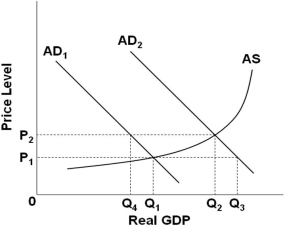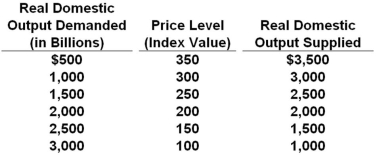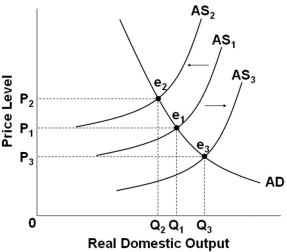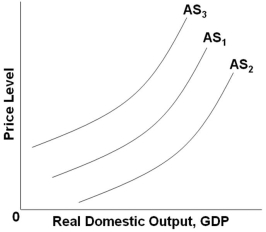A) Becomes flatter at output levels above the full-employment output
B) Becomes steep at output levels above the full-employment output
C) Is upward-sloping with a constant slope
D) Is horizontal
F) A) and D)
Correct Answer

verified
Correct Answer
verified
Multiple Choice
A decrease in aggregate demand in the short run will reduce:
A) Both real output and the price level
B) The price level and increase the real domestic output
C) The real domestic output and have no effect on the price level
D) The price level and have no effect on real domestic output
F) None of the above
Correct Answer

verified
Correct Answer
verified
Multiple Choice
The slope of the immediate-short-run aggregate supply curve is based on the assumption that:
A) Both input and output prices are fixed
B) Neither input nor output prices are fixed
C) Input prices are flexible but output prices are fixed
D) Input prices are fixed but output prices are flexible
F) A) and C)
Correct Answer

verified
Correct Answer
verified
Multiple Choice
If the price of crude oil decreases, then this would most likely:
A) Decrease aggregate supply in the U.S.
B) Increase aggregate supply in the U.S.
C) Increase aggregate demand in the U.S.
D) Decrease aggregate demand in the U.S.
F) A) and B)
Correct Answer

verified
Correct Answer
verified
Multiple Choice
 Refer to the figure above. The massive increase in government spending during World War II moved the economy in the span of a few short years from mass unemployment and price stability to "overfull" employment. This situation can be best illustrated in the figure above as a:
Refer to the figure above. The massive increase in government spending during World War II moved the economy in the span of a few short years from mass unemployment and price stability to "overfull" employment. This situation can be best illustrated in the figure above as a:
A) Shift from AD2 to AD1
B) Shift from AD1 to AD2
C) Movement along AD1 from Q4 to Q1
D) Movement along AD2 from Q2 to Q3
F) A) and C)
Correct Answer

verified
Correct Answer
verified
Multiple Choice
It shows the aggregate demand and aggregate supply schedule for a hypothetical economy.  Refer to the table above. If the quantity of real domestic output demanded decreased by $500 and the quantity of real domestic output supplied increased by $500 at each price level, the new equilibrium price level and quantity of real domestic output would be:
Refer to the table above. If the quantity of real domestic output demanded decreased by $500 and the quantity of real domestic output supplied increased by $500 at each price level, the new equilibrium price level and quantity of real domestic output would be:
A) 150 and $1500
B) 150 and $2000
C) 200 and $2000
D) 250 and $2000
F) All of the above
Correct Answer

verified
Correct Answer
verified
Multiple Choice
The labels for the axes of an aggregate supply curve should be:
A) Real domestic output for the vertical axis and price level for the horizontal axis
B) Real domestic output for the horizontal axis and price level for the vertical axis
C) Real employment for the vertical axis and price level for the horizontal axis
D) Aggregate demand for the vertical axis and real national output for the horizontal axis
F) B) and C)
Correct Answer

verified
Correct Answer
verified
True/False
The aggregate expenditures model and the immediate-short-run aggregate supply have similar assumptions regarding the economy's price level.
B) False
Correct Answer

verified
Correct Answer
verified
Multiple Choice
The foreign purchases effect on aggregate demand suggests that a:
A) Fall in our domestic price level will increase our imports and reduce our exports, thereby reducing the net exports component of aggregate demand
B) Fall in our domestic price level will decrease our imports and increase our exports, thereby reducing the net exports component of aggregate demand
C) Rise in our domestic price level will increase our imports and reduce our exports, thereby reducing the net exports component of aggregate demand
D) Rise in our domestic price level will decrease our imports and increase our exports, thereby reducing the net exports component of aggregate demand
F) C) and D)
Correct Answer

verified
Correct Answer
verified
Multiple Choice
An increase in investment and government spending can be expected to shift the:
A) Aggregate expenditures curve downward and the aggregate demand curve leftward
B) Aggregate expenditures curve upward and the aggregate demand curve leftward
C) Aggregate expenditures curve downward and the aggregate demand curve rightward
D) Aggregate expenditures curve upward and the aggregate demand curve rightward
F) B) and D)
Correct Answer

verified
Correct Answer
verified
Multiple Choice
If at a particular price level, real output from producers is greater than real output desired by purchasers, then there will be a general:
A) Surplus and the price level will rise
B) Surplus and the price level will fall
C) Shortage and the price level will rise
D) Shortage and the price level will fall
F) All of the above
Correct Answer

verified
Correct Answer
verified
Multiple Choice
When the price level decreases:
A) The demand for money falls and the interest rate falls
B) Holders of financial assets with fixed money values decrease their spending
C) Holders of financial assets with fixed money values have less purchasing power
D) There is a decrease in consumer spending that is sensitive to changes in interest rates
F) A) and C)
Correct Answer

verified
Correct Answer
verified
Multiple Choice
The economy experiences a decrease in the price level and an increase in real domestic output. Which is a likely explanation?
A) Consumer incomes and the quantity of labor have decreased
B) Business costs and wage rates have decreased
C) The prices of imported resources have increased
D) National income abroad has increased
F) B) and C)
Correct Answer

verified
Correct Answer
verified
Multiple Choice
An increase in the aggregate expenditures schedule:
A) Increases aggregate demand by the amount of the increase in aggregate expenditures only
B) Increases aggregate demand by the amount of the initial increase in aggregate expenditures times the multiplier
C) Decreases aggregate demand by the amount of the increase in aggregate expenditures
D) Decreases aggregate demand by the amount of the initial increase in aggregate expenditures times the multiplier
F) A) and C)
Correct Answer

verified
Correct Answer
verified
Multiple Choice
 Refer to the graph above. If aggregate supply shifts from AS1 to AS2, then the price level will:
Refer to the graph above. If aggregate supply shifts from AS1 to AS2, then the price level will:
A) Increase and real domestic output will increase
B) Decrease and real domestic output will increase
C) Increase and real domestic output will decrease
D) Decrease and real domestic output will decrease
F) A) and C)
Correct Answer

verified
Correct Answer
verified
Multiple Choice
 Refer to the graph above. Which line might represent an aggregate demand curve?
Refer to the graph above. Which line might represent an aggregate demand curve?
A) 1
B) 2
C) 3
D) 4
F) B) and D)
Correct Answer

verified
Correct Answer
verified
Multiple Choice
A fall in labor costs will cause aggregate:
A) Supply to increase
B) Demand to increase
C) Supply to decrease
D) Demand to decrease
F) A) and C)
Correct Answer

verified
Correct Answer
verified
Multiple Choice
Changes in the national incomes of our trading partners would directly impact our:
A) Consumption
B) Exports
C) Imports
D) Government spending
F) All of the above
Correct Answer

verified
Correct Answer
verified
Multiple Choice
An increase in productivity will:
A) Increase aggregate demand
B) Increase aggregate supply
C) Increase aggregate supply and aggregate demand
D) Decrease aggregate supply and aggregate demand
F) B) and C)
Correct Answer

verified
Correct Answer
verified
Multiple Choice
 Refer to the graph above. Which of the following factors will shift AS1 to AS3?
Refer to the graph above. Which of the following factors will shift AS1 to AS3?
A) An increase in productivity
B) An increase in input prices
C) A decrease in business taxes
D) A decrease in household indebtedness
F) None of the above
Correct Answer

verified
Correct Answer
verified
Showing 121 - 140 of 152
Related Exams